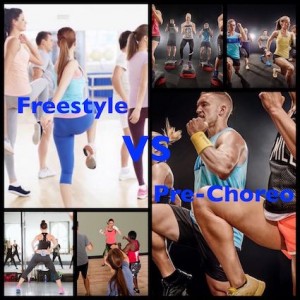Freestyle Vs Pre-Choreographed
Walk into most gyms these days and you will see fitness classes going on. There are strength based classes involving weight equipment, aerobics, circuits, boxing, aqua and mind body spirit just to name a few. Some are pre-choreographed and some are freestyle. What is the difference?
Pre-choreographed classes have been put together over a couple of months by a head choreographer. Each track has a specific focus, whether it be the body part being worked or the type of exercise being used. Songs and choreography are chosen to match the track purpose and those tracks are set in stone for that particular release. The moves and music are documented and a video is recorded to aid instructor learning. Then once the release is distributed, all instructors of that program world-wide are teaching exactly the same thing.
Freestyle classes are just that. Freestyle. The instructor will usually plan their class and choose relevant music to meet an overall class objective and the requirements of their specific participants, however, they are not restricted to follow exact choreography patterns and they can chop and change music and moves as they like.
So which is better? Well that is tough to answer as both styles have their pros and cons.
Pre-choreographed classes (like Les Mills and BTS) have usually been checked and scrutinised by physiotherapists and sports physicians before being approved for release so you know that the workout is going to be safe and effective as long as the instructor is demonstrating and coaching it correctly. Often the members prefer knowing exactly what type of a workout they will get and it will be the same no matter who teaches it. Also, although participants still have their favourite instructors, the structured choreography element makes it easier for gyms to get classes covered when required.
With freestyle classes, the instructor has the freedom to create a class which satisfies the needs and demands of the participants. Every class is unique and no class will be identical to any other, this is because the people who attend will vary. The way in which one instructor teaches the class may vary to how someone else will teach it. One downside is that it is generally thought that freestyle is dying within the fitness industry and it can be a challenge at times to find an instructor for a particular type of freestyle format.
Having sound musicology and understanding the numbers is basic for phrasing in freestyle. The instructor can then assess whether the participants can handle another layer of difficulty such as intensity or direction. It doesn’t matter how many layers the instructor has prepared, if the group can handle only the first layer then that is all that is given to them. Instead of layering in difficulty, a new group of phrasing that is also balanced, easy to follow, and yet still engaging can be incorporated.
In a pre-choreographed classes it doesn’t matter about the participant, the class is predetermined from the get go. While a pre-choreography instructor can certainly modify intensity levels by offering low impact options, the timing and moves still must remain true to the documented routine.
As an instructor of both pre-choreographed programs and freestyle, I have no preference set in stone, however when I am super busy I prefer teaching pre-choreographed classes as the routine and music are set for me. When I have time and am feeling creative, I prefer freestyle because it gives me a chance to create new combinations and moves and to make new playlists. I personally believe that there is definitely a place for both types of classes within the fitness industry and I’d especially like to see a renewed interest in freestyle and more training opportunities for instructors to get creative guidance in teaching some of the old favourites like step, hi lo and circuit.
